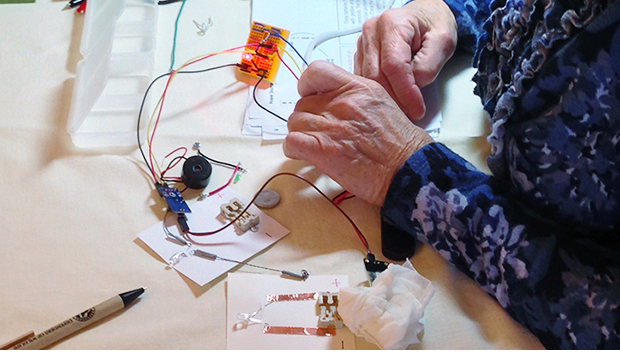Viz prof to learn if creative tech projects aid seniors' well-being

Jinsil Hwaryoung Seo
Can older adults improve their psychological well being by creating art with basic electronics?
Jinsil Hwaryoung Seo, Texas A&M assistant professor of [visualization] (http://viz.arch.tamu.edu) , is seeking to answer this and related questions in a series of seniors’ art workshops at assisted living homes and a local art gallery.
In the workshops, which Seo will host with an interdisciplinary team of researchers, seniors will create simple electronic circuits, such as connecting batteries to LED lights with wires and tape, then incorporate the technique to create greeting cards for friends and family.
Before and after the workshops, Seo and Lisa Geraci, professor of psychology, will compare the seniors’ sense of social connectedness, their interest in art, their confidence in using new technology, and their psychological state with a group of seniors working with traditional arts-and-crafts materials.
The two-year study received $18,000 funding from the [National Endowment for the Arts’ Art Works] (https://www.arts.gov/grants-organizations/art-works/grant-program-description) initiative, which supports research that investigates the value and impact of the arts.
The project is the latest of a series of Seo’s efforts to bring technology-based, interactive experiences to senior citizens.
As head of the [Soft Interaction Group] (http://softinteraction.com) in the Department of Visualization, Seo leads undergraduate and graduate students who [develop] (http://one.arch.tamu.edu/news/2015/3/10/interactive-toys/) soft toys and installations with alternative interfaces that encourage users young and old to more naturally and intuitively engage with electronics.
One of the group’s creations, “Touchology,” is a series of real and artificial plants that, when touched, produce sounds of running water or bird songs from electronic components in their bases. Another installation in the series is a set of grasslike fiber optic strands that respond to touch by displaying lighting patterns on the tips of the fibers.
“We took the plants to a local nursing home, and the residents just loved them,” Seo said. “The nursing home activity director said residents were smiling the entire time they interacted with the plants, and that they had never reacted so positively to something brought to the facility.”
Seo, who joined the Texas A&M faculty in 2011, was recognized as a 2015 Montague- [Center for Teaching Excellence] (http://cte.tamu.edu/) scholar in 2015 for her Soft Interaction Group work and for leading classes whose students produced exhibit-worthy art.
Tags
Related Posts
NSF group melding art, science learning

Initiative fusing arts, technology education gains momentum

Viz prof-led institute to study best tech learning methods
Follow Us
Facebook Twitter Vimeo Youtube Flickr RSS
Recent Posts

Planning prof heads study of disaster housing aid

A message from the dean

Former student remembered as expert planner

Leading educator named new head of Architecture Dept.






_thumbnail_small.png)
